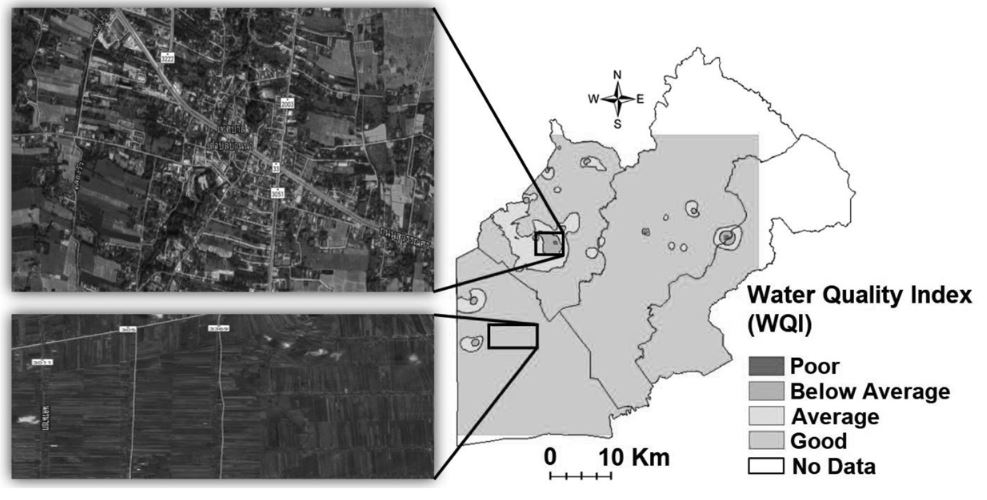Impact of Urbanization on Quality and Quantity of Groundwater in Nakhon-Nayok Province, Thailand
Keywords:
groundwater quality, groundwater quantity, groundwater management, geographical information system, program r, water quality indexAbstract
Groundwater has become an essential resource over the past few decades due to climate change, which highly increases the demand for using freshwater. The groundwater quality and quantity are then a significant criterion in matching water demand and supply. The objective of the study is to integrate the application of Geographic Information System (GIS) and Program R with the Water Quality Index (WQI) for the evaluation of groundwater quality and quantity in Nakhon-Nayok province, Thailand. The result of the study shows that the most community in western study area (Amphoe Ban Na) has WQI on average and below average levels. As a result, the urbanization can obviously impact on groundwater quality and quantity in the study area. Appropriate methods for monitoring and improving groundwater quality and quantity in affected areas should be suggested, especially in urban areas. In addition, this study indicates that the application of GIS and Program R with the WQI can be an effective tool and help more efficiently for groundwater management.
Downloads
References
Aghazadeh, N., & Mogadda, A.A. (2010). Assessment of groundwater quality and its suitability for drinking water and agricultural uses in the Oshnavieh area, northwest of Iran. Journal of Environmental Protection,1,1(January 2010), 30–40.
Alam, M., & Pathak, JK. (2010). Rapid assessment of water quality index of Ramganga River, Western Uttar Pradesh(India) using a computer program. Nature and Science, 8 (11), 1-8.
Arsalan, M.H. (2004). A GIS appraisal of heavy metals concentration in soil. American Society of Civil Engineers,New York, 8(4), 10017-2398.
Asadi, SS., Vuppala, P., & Reddy, M.A. (2007). Remote sensing and GIS techniques for evaluation of groundwater quality in municipal corporation of hyderabad (zone-v). International Journal of Environmental Research Public Health, 4(1), 45-52.
Belkhiri, L., Boudoukha, A., & Mouni, L. (2011). A multivariate statistical analysis of groundwater chemistry data. Journal of Environmental Resources,5(2), 537–544.
Bohlke, J.K., Wanty, R., Tuttle, M., Delin, G., & Landon, M. (2002). Denitrification in the recharge area and discharge area of a transient agricultural nitrate plume in a glacial outwash sand aquifer, Minnesota. Water Resources Research,38, 10.1-10.26.
Brindha, K., & Elango, L. (2011). Fluoride in Groundwater: Causes, Implications and Mitigation Measures. Fluoride Properties, Applications and Environmental Management. Edition: 1. Nova Science Publishers: New York, USA, 111-136.
Chaudhuri, S., & Ale, S. (2014). Long term (1960-2010) trends in groundwater contamination and salinization in the Ogallala aquifer in Texas. Journal of Hydrology, 513, 376-390.
Department of Groundwater Resources. (2018). Ministry of Natural Resources and Environment, Thailand. Retrieved from http://app.dgr.go.th/newpasutara/xml/Krabi.files/show.php
Department of Nakhon-Nayok Province. (2016). Ministry of Interior, Thailand. Nakhon-Nayok Province of Annual Report 2016. [Report].
Ho, P.N. (2012). Total water quality index using weighting factors and standardized into a parameter.Environment Asia,5(2), 63-69.
Jerome, C., & Pius, A. (2010). Evaluation of water quality index and its impact on the quality of life in an industrial area in Bangalore, South India. American Journal of Scientific and Industrial Research. DOI:10.5251/AJSIR.2010.1.3.595.603
Jones, W.R. Spence, M.J., & Bonte, M. (2014). A software tool for the spatiotemporal analysis and reporting of groundwater monitoring data. Environmental Modelling & Software,55, 242-249.
Juntakut, P. Snow, D.D. Haacker, E.M.K., & Ray, C. (2019). The long-term effect of agricultural, vadose zone and climatic factors on nitrate contamination in the Nebraska’s groundwater system. Journal of Contaminant Hydrology, 220, 33-48.
Kebede, S. Travi, Y. Alemyehu, T., & Anyenew, T. (2005). Groundwater recharge, circulation and geochemical evolution in the source region of the Blue Nile River, Ethiopia. Applied Geochemistry, 20, 1658–1676.
Krauskopf, K.B., & Bird, D.K. (1995). An introduction to geochemistry. McGraw-Hill Int.: Singapore, 647.
Mongeli, G. Monn, S. Oggiano, G. Paternoster, M., & Sinisi, S. (2013). Tracing groundwater salinization process in coastal aquifers: a hydrogeochemical and isotopic approach in the Na–Cl brackish water of north-western Italy. Hydrology and Earth System Sciences, 17, 2917–2928.
Nolan, B.T. & Hitt, K.J. (2006). Vulnerability of shallow groundwater and drinking-water wells to nitrate in the United States. Environment Science Technology, 40(24), 7834-7840.
Poonam, T. Tanushree, B., & Sukalyan, C. (2013). Water quality indices-important tools for water quality assessment: a review. International Journal of Advances in Chemistry,1(1).
Sadashivaiah, C. Ramakrishnaih, C.R., & Ranganna, G. (2008). Hydrochemical analysis and evaluation of groundwater quality in Tunkur Taluk, Karnataka State, India. International Journal of Environmental Research Public Health,5(3), 158–164.
Sungsitthisawad, W., & Pitaksanurat, S. (2013). Groundwater quality index for water supply production. EnvironmentAsia, 6(2), 18-23.
Tiwari, T.N., & Mishra, M. (1985). A preliminary assignment of water quality index to major Indian rivers. Indian Journal of Environmental Protection,5(4), 276-279.
Tjandra, F.L. Kondhoh, A., & Aslam, M.M.A. (2003). A conceptual database design for hydrology using GIS. Proceedings of Asia Pacific Association of Hydrology and Water Resources, Kyoto, 13-15.
Turner, R. (2012). deldir: Delaunay Triangulation and Dirichlet (Voronoi) Tessellation. R Package Version 0.0-19. URL. Retrieved from http://CRAN.R-project.org/package¼deldir.
Vandenbohede, A., & Lebbe, L. (2012). Groundwater chemistry patterns in the phreatic aquifer of the central Belgian coastal plain. Applied Geochemistry,27, 22–36.
Wannakomol, A. (2005). Soil and groundwater salinization problems in the Khorat Plateau, NE Thailand- integrated study of remote Sensing, geophysical and field data. Freie Universität: Berlin, Germany.
World Health Organization. (2008). Guidelines for drinking water quality. 3rd ed. WHO Headquarters in Geneva: Geneva, Switzerland, 296-402.

Downloads
Published
How to Cite
Issue
Section
License
Copyright (c) 2019 International Journal of Building, Urban, Interior and Landscape Technology (BUILT)

This work is licensed under a Creative Commons Attribution-NonCommercial-NoDerivatives 4.0 International License.











